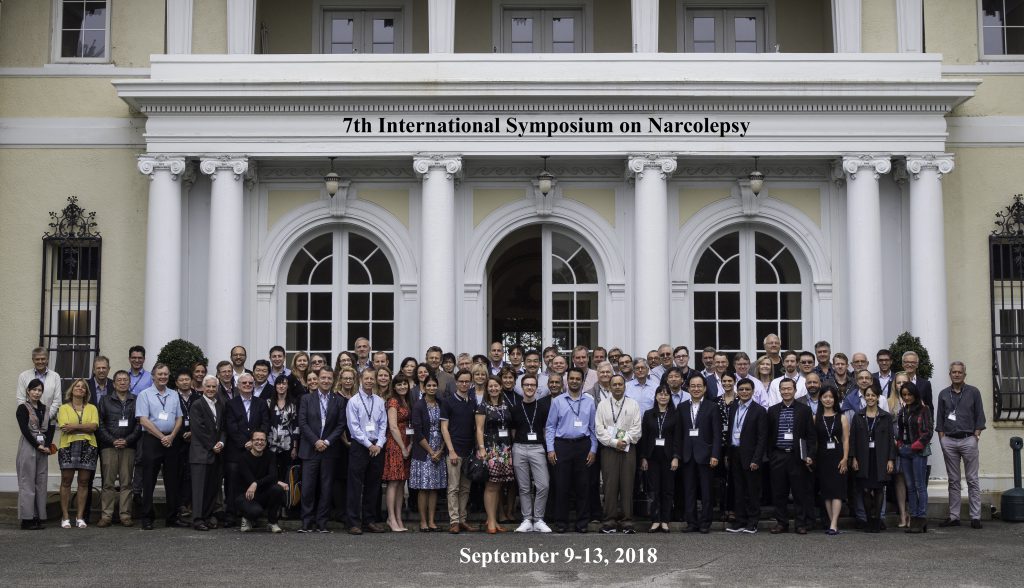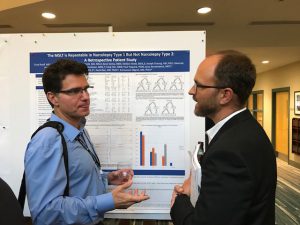SomnusNooze

The 7th International Symposium on Narcolepsy, held in Boston earlier this fall, gathered both basic and clinical researchers from around the globe so they could share their latest findings with each other to help advance the field. Representatives from several patient support groups, including the Hypersomnia Foundation, Narcolepsy Network, Project Sleep, and Wake Up Narcolepsy, attended the symposium as well, not only to share stories (especially those that happen outside of the doctor’s exam room) from people diagnosed with or caring for an individual with hypersomnolence, but also to help disseminate findings from this conference. The various representatives from patient support groups helped guide the direction of future research initiatives. The Hypersomnia Foundation was well represented by: Drs. David Rye (SAB), Lynn Marie Trotti (MAB), Kiran Maski (MAB), Isabelle Arnulf (MAB), and Chad Ruoff (MAB); and Board Members Catherine Rye and Mary King. The research presented focused mainly on the causes and new treatments for narcolepsy type 1 (NT1) (e.g., how the immune system may cause NT1) and type 2 (NT2); however, findings relevant to the idiopathic hypersomnia (IH) community were also presented and discussed.
Our own MAB member, Dr. Chad Ruoff, has summarized the highlights of this important week-long meeting, with input from many members of our MAB and SAB, exclusively for SomnusNooze. (EDITOR’S NOTE: Due to the length of the Symposium and the amount of material presented by the speakers, we are presenting his Summary in two parts – the first part is set forth below, while the second part will be included in an upcoming SomnusNooze.)
DR. RUOFF’S SUMMARY (Part 1 of 2):
Many prominent sleep medicine physicians spoke and presented their research at this Symposium, including:
DR. DAVID RYE: Dr. Rye of Emory University reviewed his data on IH, including the finding of GABA potentiation in the cerebrospinal fluid of patients with IH and NT2, as well as the treatment of hypersomnias with medications such as clarithromycin and flumazenil (and others), which counter the effect of GABA. In the last few years, more than 100 U.S. physicians have prescribed flumazenil through a single compounding pharmacy in Atlanta. Several pharmaceutical companies are exploring the potential benefits of such medications, which represent an entirely new avenue of treatment compared to traditional wake-promoting drugs.
DR. LYNN MARIE TROTTI: Dr. Trotti of Emory University reported that sleep inertia (i.e., difficulty with morning awakenings, not feeling rested after a nap, trouble functioning with normal alertness upon awakening, and needing multiple alarm clocks) was more common in those with IH, especially those with long sleep times, compared to those with NT1 and NT2. She did, however, report somewhat more symptom overlap between patients with IH and NT2. This study was made possible by analyzing data from the Coordination of Rare Diseases at Sanford (CoRDS) in addition to a Boston University database (BUNIHPPS Questionnaire). Read More HERE.
DR. KIRAN MASKI: Dr. Maski of Harvard University reported a measure of disrupted nighttime sleep (DNS) for children (approximately 8 to 16 years of age) with NT1. This DNS measure includes frequent sleep transitions from stable sleep (light, deep, and/or REM sleep) to light sleep/wakefulness. Like pediatric NT1 patients, children with IH return to sleep faster after waking up but have more stable NREM and REM sleep.
DR. ISABELLE ARNULF: Dr. Arnulf of the Sorbonne Universités and Pierre & Marie Curie University, reported on her team’s study into whether people with narcolepsy were more creative than the general population. Because narcolepsy is characterized by sudden and more “intense” REM sleep episodes, often associated with vivid and lucid dreams, her team evaluated creative thinking in patients with narcolepsy and in controls, using creativity and achievement questionnaires, as well as face-to-face tests. Dr. Arnulf’s team found that patients with narcolepsy are indeed more creative than the general population, supporting a role for increased consciousness during REM sleep in creative thinking.
DR. RICHARD BOGAN: Dr. Bogan of the University of South Carolina performed a sophisticated analysis of brain waves (called quantitative EEG analysis) on patients with narcolepsy, IH, and healthy controls, finding that IH patients have 3 times the amount of low frequency segments (i.e., deep sleep) compared to controls. Interestingly, patients with narcolepsy demonstrated peak amounts of REM sleep about 45 minutes earlier in the night than controls.
DR. ROBERT THOMAS: Dr. Thomas of Harvard University reported on the use of 24-hour urine 6-sulfatoxymelatonin (measured every three hours, in darkness, at home), in addition to sleep logs, actigraphy, and polysomnography (time unrestricted), to measure the ‘biological night’ in 50 patients (mean age 37 years) with idiopathic hypersomnia. The ‘biological night,’ according to melatonin levels, was greater than or equal to 12 hours in 40 patients, with an average duration of 16 hours. Actigraphy data demonstrated sleep times of 9 hours during the week and 14 hours during the weekend. Self-reported unconstrained total sleep time capability was 16 hours. Polysomnographic total sleep time averaged just over 12 hours. Dr. Thomas also reported a benefit with bright light therapy timed to the edges of the biological night in 80% (32 out of 40) of patients with a long biological night.
 Dr. Ruoff (right) discussing his research poster with Markus Schmidt, MD, PhD (left)
Dr. Ruoff (right) discussing his research poster with Markus Schmidt, MD, PhD (left)
In addition, several recent retrospective studies, including one by DR. CHAD RUOFF of Stanford University, which was presented at this conference as a poster, as well as a study by DR. LYNN MARIE TROTTI, suggest that an initial MSLT diagnosis of NT2 or IH is not a stable finding when the MSLT is repeated (i.e., the repeat MSLT diagnosis may change from NT2 to IH or to a ‘normal’ MSLT). DR. SEUNG-CHUL HONG of Catholic University of Korea presented a similar experience in Korea. The Korean data demonstrated that, upon repeating the MSLT, the diagnosis changed in 40% of people with NT2 and 75% of people with IH. This is especially concerning for people with IH, since there are no FDA-approved medications for IH. Given these findings that call into question the stability of the MSLT across time, the conference dedicated almost an entire afternoon’s discussion to ways to improve both diagnosis and classification of NT1, NT2, and IH.
This concludes Part 1 of the Summary. Part 2 will appear in an upcoming SomnusNooze and will review the research findings about the frequency of narcolepsy and IH diagnoses, orthostatic intolerance and POTS, and the new data on the SIK3 mouse model, which shares some similarities to people with IH!
Summary prepared by Dr. Chad Ruoff, with additional input by Drs. David Rye, Lynn Marie Trotti, Kiran Maski, and Robert Thomas
And if you have enjoyed Part 1 of this Summary about the latest research into sleep disorders, please consider making a donation to the Hypersomnia Foundation HERE today! As a nonprofit charitable organization, we are dependent on your generosity to fulfill our mission of raising awareness of, and increasing research into, IH and related sleep disorders.
